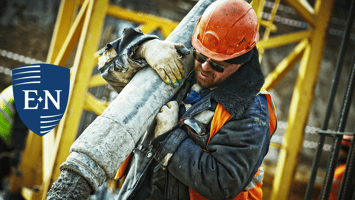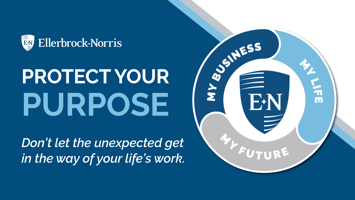Workers’ Compensation Experience Modification Rate: How It’s Calculated and Strategies for Reduction
Workers’ compensation is a vital part of protecting employees and maintaining a safe workplace. Yet...
-1.png?width=1400&height=788&name=Blog%20Image%20(5)-1.png)
The experience modification rate definition might sound like something only your insurance agent needs to know – but for business owners, it’s one of the most important numbers in your entire risk profile. Also called E-Mod, EMR, X-Mod or Mod Rate, your experience modification rate can quietly drive up your Workers’ Compensation premiums, keep you from winning contracts and shrink your profits without you even realizing it.
Here’s the good news: once you understand the experience modification rate definition and how it’s calculated, it becomes more than just a number – it becomes a tool you can actually use. A strong E-Mod can cut costs, help you qualify for more work, and prove your commitment to safety.
In this guide, we’ll break down what the experience modification rate definition really means, how it’s calculated, the factors that influence it and why it reflects more than just insurance – it reflects the way your business operates.
Before we go further, let’s start with the experience modification rate definition itself: it’s a numeric score that compares your actual workers’ compensation claims and injury history to what’s expected for a business of your size and industry.
Your E-Mod is calculated by the National Council on Compensation Insurance or a state rating agency, and usually falls between 0.50 and 2.00, with 1.00 being the industry average for companies similar to yours.
Here’s a quick cheat sheet:
Even a small shift in your E-Mod can make a noticeable difference. A company with an E-Mod of 1.20 could be paying 20% more for Workers’ Compensation than average and 40% more than a competitor with an E-Mod of 0.80.

Understanding the experience modification rate definition is the first step; the next is knowing how it’s determined. Your E-Mod is based on real data from your business over time, or more specifically, the last three years of claim history plus the total payroll by job classification and the industry you operate in. This excludes your most recent policy year.
Here’s what goes into the formula:
This is the number of claims you’re expected to have based on your:
Larger businesses in higher-risk industries will naturally have higher expected losses, so this system adjusts accordingly.
This is your real-world claim history, which includes:
Lost-time claims weigh more because they signal more serious disruptions to your employees and your operations. We’ll hit on this more later on.
Not all claims are treated equally. Claims frequency is weighted more heavily than claims severity. There are two potential parts to a claim – primary losses and excess losses.
This system penalizes frequent claims more than occasional larger ones since repeat issues usually point to unsafe practices or a lack of training.
The smaller your business, the more one claim can skew your E-Mod.
Larger companies have more data, so individual claims move the needle less. That’s why the E-Mod formula includes a credibility modifier – it helps even the playing field between companies of different sizes.
For smaller teams, this makes consistent safety habits even more important.
.png?width=1920&height=1080&name=Blog%20Graphics%20(8).png)
It's one thing to know the Experience Modification Rate definition, but it's another to understand it's whole picture. It's not just an internal metric – it tells a story. To insurers, partners and clients, it signals how well you manage workplace risk. Depending on where that number falls, it can either save you money or quietly cost you opportunities.
Here’s how it plays out:
Think of your E-Mod as a pricing dial for your workers’ comp policy.
Let’s say your base premium is $75,000:
Insurance carriers also use the E-Mod to gauge your safety culture, which means that a high score can raise red flags even when you’re shopping for other policies like general liability or commercial auto.
In industries like construction, your Experience Modification Rate doesn’t just impact your premiums, it can impact your pipeline.
Many project owners and general contractors require a sub-1.0 E-Mod just to qualify for a job. If you’re above that mark, you may never even make it to the table. This becomes especially important as you deal with global companies, larger contractors or government contracts.
Inside your business, Experience Modification Rate is a pulse check on your safety culture. Outside, it’s a reputation-builder. It tells employees you prioritize their well-being, clients that you run a tight ship and insurers that you take risk seriously.
You may have an excellent safety culture and still experience an E-Mod increase. Often, this is due to lack of understanding in how the E-Mod is calculated. You’re more greatly impacted if the injury results in lost time for that employee, if it’s classified as one certain type of injury over another, and even what body part is injured.
Luckily, if you take the time to understand what goes into the E-Mod, you may be able to reduce your rate.
Now that you know the Experience Modification Rate definition, what your score reflects and how much it impacts your bottom line, the next question is: how do you improve it?
There’s no quick fix. The E-Mod looks at performance over time, so improvement takes consistency. But with the right steps, the rewards add up: lower premiums, better client trust and a safer workforce.
Here’s how to start shifting the needle:
The most obvious impact to your E-Mod comes from safety practices.
Too often, safety gets reduced to a list of rules. But if you want lasting impact, it needs to be part of how your business actually runs.
For many teams, working with a dedicated safety consultant can make that shift more manageable – helping you identify blind spots, ensuring your jobsite or facilities are safe, and build a program that fits the way your people work.
We break this down even further in our article on how safety programs directly impact your E-Mod – including what to focus on first if you’re just getting started.
Like we mentioned earlier, lost-time claims weigh more heavily on your E-Mod than medical-only claims. That’s why a return-to-work program can make such a big difference.
By creating light-duty or transitional roles for injured employees, you can often keep claims classified as medical-only instead of lost-time. That shift can reduce the claim’s impact by 70% in some states.
If you’re exploring how to put this in place, this breakdown of return to work strategies can help you build one that works for your people and your bottom line.
Everyone has the right to choose their own healthcare providers. As an employer, you are allowed to suggest providers who you know have experienced in your industry.
For example, if your employee drives a skid loader all day and breaks a finger, he may not need to miss time. But if that same employee swings a hammer all day or is doing detailed work that requires dexterity in his finger, he may need to shift his duties. A doctor experienced in the construction industry may be able to help specify duties more than a general physician.
In addition to preferred providers, you should also have a form that specifies exactly which duties can or cannot be performed. This will help you find a role for the employee that may not require them to miss time, thus helping your E-Mod.
Your claims history isn’t just paperwork – it’s a map. Every injury, no matter how small, is a clue. Maybe the same type of incident is happening in one department. Maybe new hires are getting hurt more often. When you track and review every incident, patterns start to emerge.
That’s when you can step in with better training, updated procedures or equipment changes before a small issue turns into a long-term trend.
Your frontline leaders are the first to spot risks and respond. But do they know what to do?
Investing in supervisor training doesn’t just protect your team. It helps ensure incidents are documented correctly, temporary duty options are explored and your safety culture has champions at every level.
We can help do that through our leadership training program.
At the end of the day, understanding the experience modification rate definition is more than just knowing a number – it’s understanding how your business manages risk. It signals whether you’re being reactive or proactive, whether safety is a priority or an afterthought.
Improving your E-Mod is important. But it’s not the full story.
To build a business that lasts, you need to look at the bigger picture: How are you preventing injuries in the first place? What happens when someone does get hurt? Are your supervisors trained to lead on safety? Are your providers aligned with your goals? Do you have a return-to-work plan that works?
That’s what holistic risk management is all about – connecting the dots between prevention, response and long-term strategy. And it’s where many businesses realize they need more than just a policy. They need a partner.
The ENCORE Safety Network was built to give business owners the support they need to create and sustain a real safety culture – not just a paper program.
Here’s just some of what we offer:
The Safety Network is more than a service. It’s a network of support that helps you move from compliance to culture, from reacting to risks to getting ahead of them.
Because when you treat safety as part of your strategy – not just a checklist – everything else gets easier: hiring, retention, uptime, claims, premiums and peace of mind.
Connect with our team and see how we can help you protect your purpose today.

Workers’ compensation is a vital part of protecting employees and maintaining a safe workplace. Yet...
.png?height=200&name=Untitled%20design%20(9).png)
What is a risk consultant – and why are more and more business owners relying on one? Running a...

There is a need for more insurance practitioners to rethink how the industry safeguards clients...